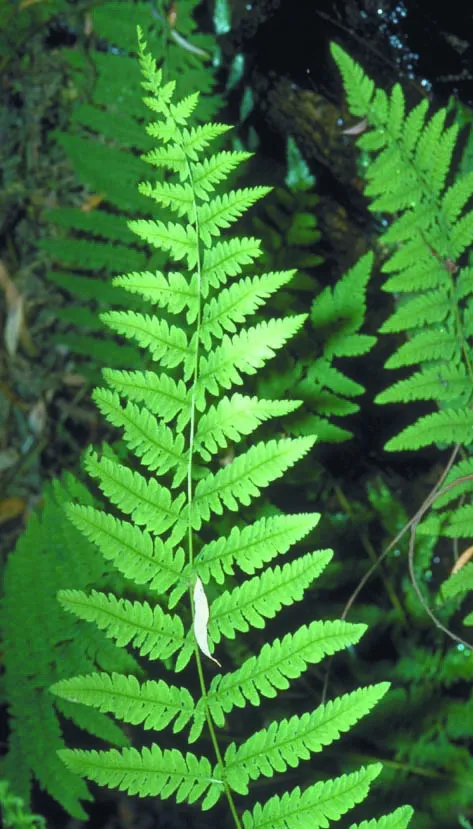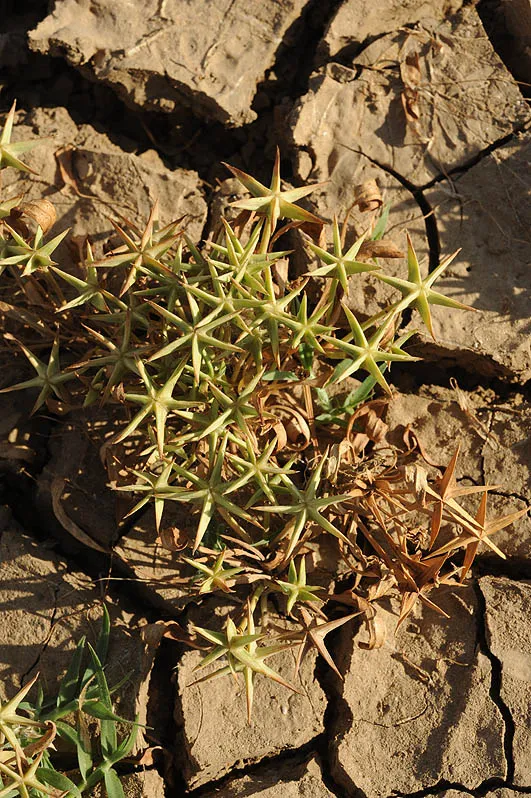Eastern Marsh Fern, Marsh Buckler Fern
Thelypteris palustris

Thelypteris palustris has been known for about a hundred years, only from
the Hula Valley, and currently it grows only in the Tel
Dan Nature Reserve. Before the drainage of the Hula marshes, it grew in a
number of sites within the marsh: at the site where the Jordan River flowed
into the Hula marshes, in the marsh and between Malaha and Jordan (drainages
from 1940-1950). In the Tel Dan Nature Reserve T.
palustris is found at the edge of the upper dam that is
near the main spring, in the Fraxinus syriaca understory, as
well as in the aqueduct between the Dan Stream and Kibbutz Dafna. According to Danin
(2004), T. palustris is noted in the
literature as also existing in the Golan and Upper Galilee regions.
Marshes and riverbanks, particularly bordering on fresh, flowing
streams, in full light, half-shade or complete shade. T.
palustris clumps form natural islands in the Dan Stream channel. The base of some of the plants is immersed in water.
The genus Thelypteris has 280 species
of ferns found across all continents of the world, in both tropical and temperate areas. The
Australian tree ferns also belong this fern family. Thelypteris
palustris is morphologically similar to Dryopteris villarii. Both have similar
bipinnate leaves (Pteridium aquilinum has
tripinnate leaves) and the lobes of each leaflet are similar. However, in Dryopteris the spores are arranged in two rows close to the leaflet margin, whereas in T. palustris the sporangia are spread
over the entire leaf area.
Despite the broad global distribution
of Thelypteris palustris, which probably results
from its tremendous capability for dispersing spores, in
terms of diversity conservation, this one the rarest plants in Israel – with only a few plant
clumps limited to the Tel Dan Nature Reserves. Thus, in all of Israel, only 4-8 plant
clumps survive, whereas many plants once grew in the Hula marshes. Therefore, even though the plants grow in a reserve, they are in immediate danger of extinction, whether randomly or
accidentally, due to changing water levels or any other disturbance.
The Thelypteris
palustris plants in the Tel Dan Nature
Reserve should be
monitored twice yearly and a
thorough survey of the
reserve should be
carried out to count and mark
new plants. A second site should be populated with T.
palustris and populations should be established, on
the banks of the Jordan
River. T. palustris should be reintroduced to the Hula
Reserve and to the restored Hula Lake following the development of suitable
habitats.
Thelypteris palustris has a broad range
extending over all the continents of the globe
(except Australia): around the Mediterranean countries, except Egypt; it also grows in the Canary and Cape Verde islands. In Asia T. palustris grows in the Caucasus, Iran,
Afghanistan, Himalayas, Central Asia, India, China, Japan and the Polynesian
Islands. It is found throughout Europe and in the Black Sea region and Asiatic Russia. It also grows in North America, New Zealand, tropical Africa, and South Africa
and in East Africa.
Thelypteris palustris is an
example of wetland
plants having Israel as their southernmost distribution
limit in the Mediterranean Basin. The plant is
critically endangered, even though it grows in a nature reserve; it grows in only a single site in Israel and there is a negligible number
of plants
there. Although the species has a wide global distribution and is not globally
endangered, from the Israeli perspective, the species is
severely threatened.
שמידע א. ולב-ארי, י. 1975. שמורת תל-דן. בתוך קובץ שמירת הטבע בישראל. דו"ח מספר 1, רשות שמורות הטבע.
Current Occupancy Map
| 1000 squre meter pixel | 5000 squre meter pixel | 10000 squre meter pixel | |
|---|---|---|---|
| number of observations | 0 | 0 | 0 |
| in total pixels | 0 | 0 | 0 |
| Family | Thelypteridaceae |
| Classification | On the endangered species list |
| Ecosystem | Mediterranean humid |
| Chorotype | Multi-region, Temperate to Tropical |
| Conservation Site | Tel Dan Reserve |
| Rarity |
1
5
6
|
|---|---|
| Vulnerability |
0
4
4
|
| Attractiveness |
0
1
4
|
| Endemism |
0
0
4
|
| Red number |
1
5.3
10
|
| Peripherality | 0 |
| IUCN category | DD EW EX LC CR EN VU NT |
| Threat Definition according to the red book | Critically endangered |
 Based on:
Based on:






